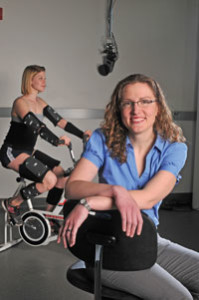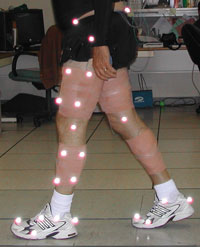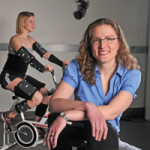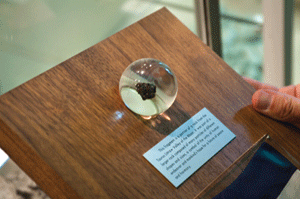
Using computer models, Silverman is getting a better understanding of how muscles contribute to movement and balance as well as energy costs and loads on joints. In her lab, she measures the human body’s motion to determine the walking challenges of those who are disabled.
Anne Silverman, assistant professor of mechanical engineering at Mines, wants to help change this, and her research is yielding some valuable information. Recently, she investigated lower-limb mechanics in individuals with an amputation. The 24 subjects she included, a little more than half of whom were amputees, had small, reflective spheres attached to their feet, ankles, shins, knees, thighs and hips. High-speed motion-capture cameras then tracked the movement of the spheres, allowing Silverman to characterize human-body motion. Silverman explains that it’s the same technology used to reproduce realistic movements for animated films and the video gaming industry.
After combining data from motion-capture and ground-force measurements, she was able to calculate the net power generated and absorbed at each joint, and so better understand how individuals with an amputation compensate during walking in the absence of a biological ankle. She also attached electrodes to her subjects’ legs to measure electrical activity in their muscles. By combining this electromyography data with other biomechanical measurements, she generated walking simulations in 3-D, which can be used to understand the roles of individual muscles and prosthetic devices in whole-body movements.
Commended for how well her approach brings a complex, dynamic system like walking into detailed and quantifiable definition, Silverman made some unexpected findings, including how little the intact leg was used by many subjects to compensate, and how much of the heavy lifting is done by hip muscles high in the amputated leg, especially when walking at faster speeds. She was also surprised by the degree of variability. “Some people are very well-adapted, physically active individuals, others with a similar amputation actually prefer a wheelchair,” Silverman says.
 Ultimately, she hopes her work will contribute to technologies that can be widely applied in a clinical setting. She points out that the number of amputees is growing, driven by factors such as an aging population that is increasingly diagnosed with diabetes and dysvascular disease. Ironically, improved medical resources on the battlefield are a contributing factor as well, since surviving a severe injury often means living with an amputation. For these people, Silverman points out, ‘improving long-term mobility can have a tremendous impact on their lives.’
Ultimately, she hopes her work will contribute to technologies that can be widely applied in a clinical setting. She points out that the number of amputees is growing, driven by factors such as an aging population that is increasingly diagnosed with diabetes and dysvascular disease. Ironically, improved medical resources on the battlefield are a contributing factor as well, since surviving a severe injury often means living with an amputation. For these people, Silverman points out, ‘improving long-term mobility can have a tremendous impact on their lives.’
Video: Watch Anne Silverman’s presentation from Alumni Weekend.






